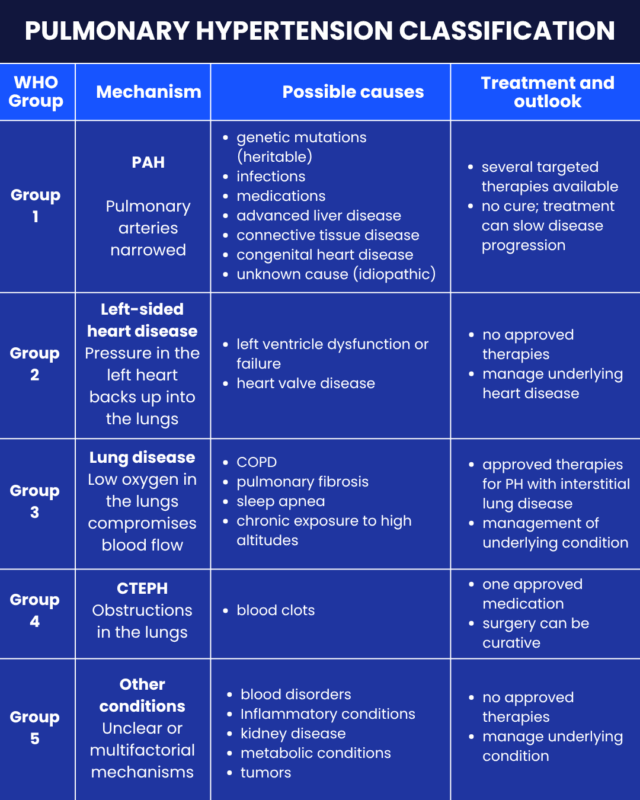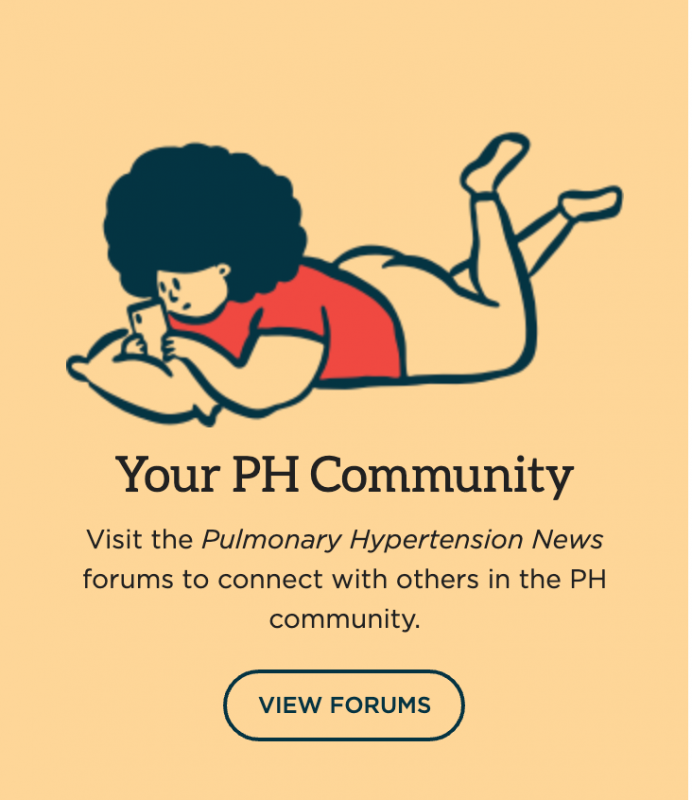Pulmonary hypertension WHO classification
Last updated Oct. 29, 2025, by Lindsey Shapiro, PhD

The World Health Organization (WHO) classifies pulmonary hypertension (PH), a progressive lung disease, into five main groups according to its underlying cause.
All types of PH are characterized by high pressure in the pulmonary arteries that deliver blood from the heart to the lungs, making the heart work harder to pump blood. This compromises oxygen delivery to the body and can ultimately strain the heart to the point of right-sided heart failure.
The disease has numerous possible causes, which form the basis of the PH WHO classification system. It’s important for the disease to be appropriately classified at the time of diagnosis because this can affect disease symptoms, treatment choices, and overall long-term outlook.

WHO Group 1
PH group 1 includes pulmonary arterial hypertension (PAH), where the pulmonary arteries become narrowed or thickened, restricting blood flow and raising pressure. There are several possible causes of PH, including:
- inherited genetic mutations, known as familial, or heritable PAH
- use of certain drugs or medications
- congenital heart disease
- connective tissue diseases, like scleroderma or lupus
- chronic liver disease
- certain infections, such as HIV
A WHO PAH classification also includes idiopathic disease, where there is no identifiable cause.
Despite being relatively rare, PAH is one of the most well-studied PH groups and the one with the most available targeted treatment options.
WHO Group 2
PH group 2 includes cases that are due to left heart disease. Problems with the left side of the heart impair blood flow and lead to pressure elevations in the pulmonary veins connecting the lungs to the left side of the heart, and blood cannot be moved away from the lungs effectively. This is known as pulmonary venous hypertension.
Heart diseases that can lead to group 2 PH include:
- dysfunction or failure of the heart’s left ventricle, which is normally responsible for pumping blood out to the body
- left-sided valve disease, where the valves that ensure proper blood flow through the chambers of the heart are dysfunctional.
Despite being the most common type of the disease, no therapies are approved for group 2 PH. Treatment involves supportive care and management of the underlying heart disease.
WHO Group 3
According to the WHO PH guidelines, PH group 3 includes cases of pulmonary hypertension due to lung disease or other conditions that result in low oxygen levels in the body. This includes:
- obstructive lung diseases, such as chronic obstructive pulmonary disease
- restrictive lung diseases, including pulmonary fibrosis and other interstitial lung diseases (ILD)
- sleep apnea, where breathing frequently starts and stops during sleep
- chronic exposure to high altitudes.
The body responds to the low oxygen levels that these conditions cause by constricting the blood vessels in the lungs. That makes it harder for blood to move through them, increasing pressure.
Disease management is focused on treating the underlying lung disease. A couple of targeted PH therapies can also be used for people with PH-ILD.
WHO Group 4
PH group 4 is also called chronic thromboembolic pulmonary hypertension (CTEPH), and refers to PH due to blood clots in the lungs that block blood flow and cause scar tissue accumulation.
Unique from other disease types, CTEPH can potentially be cured with surgery to remove the clots. One targeted PAH treatment can also be used for people with CTEPH.
WHO Group 5
PH group 5 encompasses all forms of the disease that arise secondarily to other underlying conditions, but how they lead to elevated pulmonary artery pressure is not well-understood. Conditions that can cause group 5 PH include:
- blood disorders, such as sickle cell disease or polycythemia vera
- inflammatory conditions such as sarcoidosis
- chronic kidney disease
- metabolic conditions, such as Gaucher disease, glycogen storage disease, or thyroid disorders
- tumors.
Disease management involves supportive care and treating the underlying disease.
Pulmonary Hypertension News is strictly a news and information website about the disease. It does not provide medical advice, diagnosis, or treatment. This content is not intended to be a substitute for professional medical advice, diagnosis, or treatment. Always seek the advice of your physician or other qualified health provider with any questions you may have regarding a medical condition. Never disregard professional medical advice or delay in seeking it because of something you have read on this website.
Recent Posts
- Phase 3 trials now recruiting people with PH-HFpEF to test TNX-103
- Uptravi improves physical capacity in children with PAH: Study
- When living with chronic illness, life often gives you lemons
- Living with PH means juggling an array of medical devices
- Committee supports broader Winrevair use for PAH in Europe

